I’m going to explain how Labrador color genetics works and what the probabilities of different colored puppies are, with the help of some fun diagrams. The Labrador comes in three main colors: black, chocolate, and yellow. These colors also come in few different shades, some through breeding darker tones to deeper hues like with the red fox Lab, and others through genetic differences like the controversial dilute gene.
Dilute genes make the typical Labrador Retriever colors more pale, giving you charcoal, silver and champagne Labs. You can also get mismarks, where you’ll find a splash of white on the chest, paws or toes of otherwise solidly colored dogs.
- Pictures of the different Labrador colors
- Labrador Retriever colors through history
- Coat color genetics
- Predicting colors in a litter of puppies
- Rare Labrador colors
Today I’ll look at where the colors come from, and what they mean for your dog’s personality, health, lifespan and temperament. I’ll share pictures of all the different Labrador Retriever colors, and help you to decide which one your pup fits the most!
How Many Labrador Retriever Colors Are There?
Strictly speaking, there are only three different Labrador colors:
These are the three colors recognised and accepted by the AKC in the United States, and the Kennel Club in the United Kingdom. In practice, there is a wide range of shades of yellow Labrador color, from palest cream to richest fox red.
Black Labrador
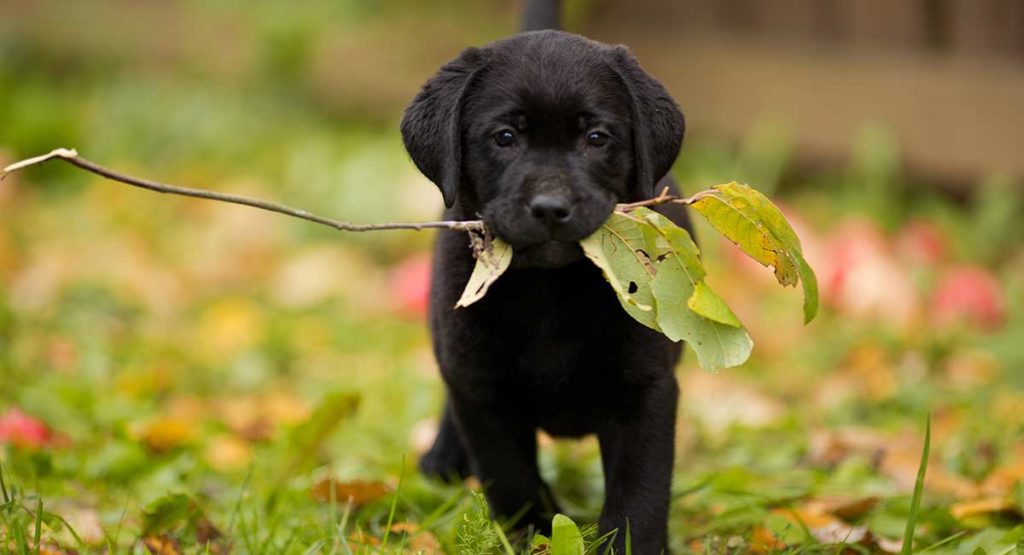
Chocolate Labrador
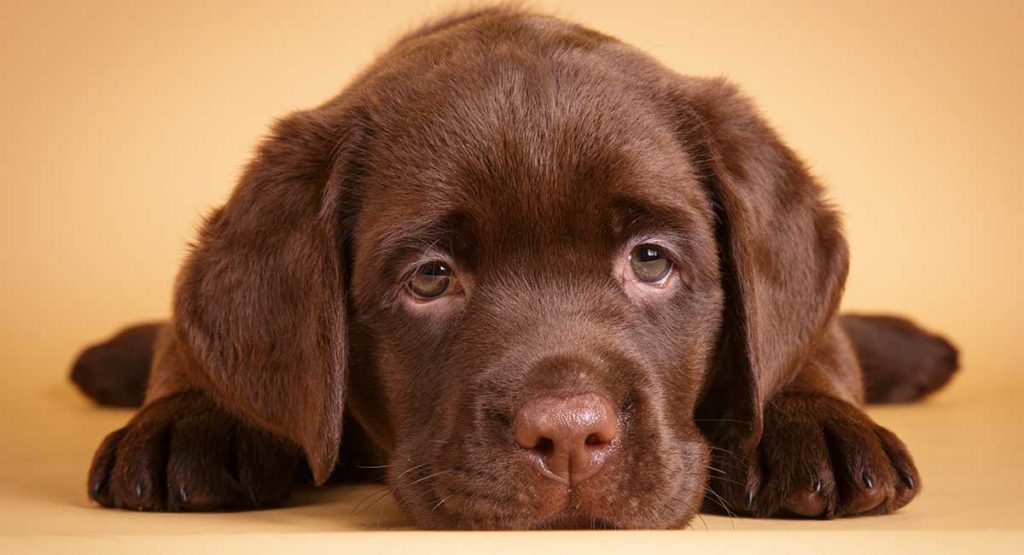
Yellow Labrador

Red Fox Labrador
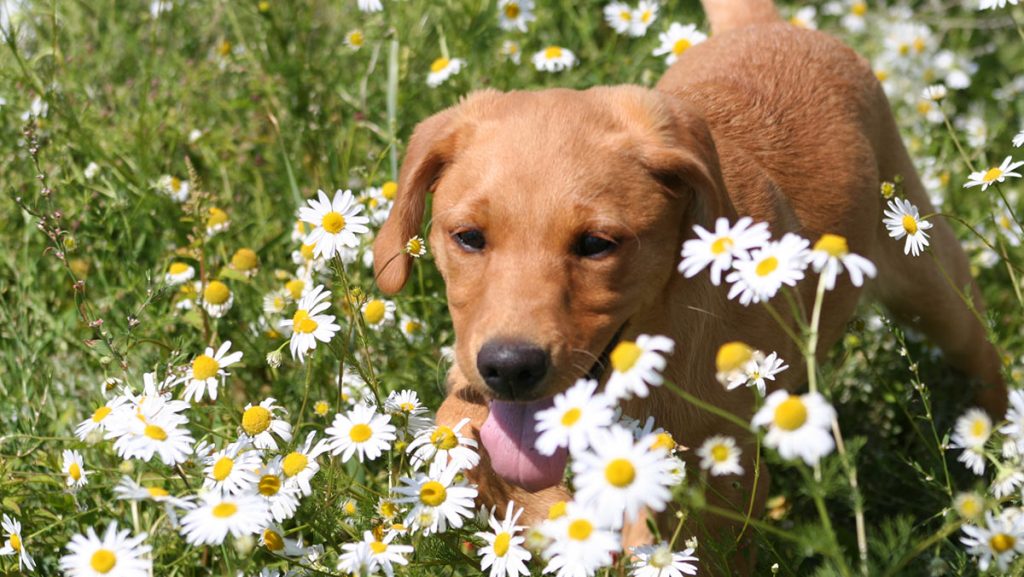
Silver Labrador
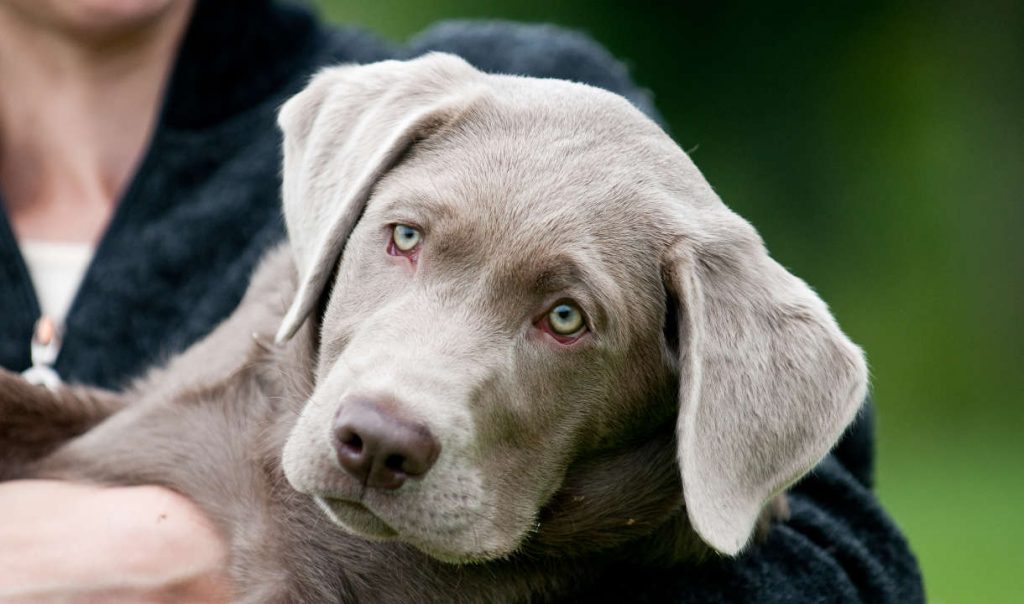
Champagne Labrador
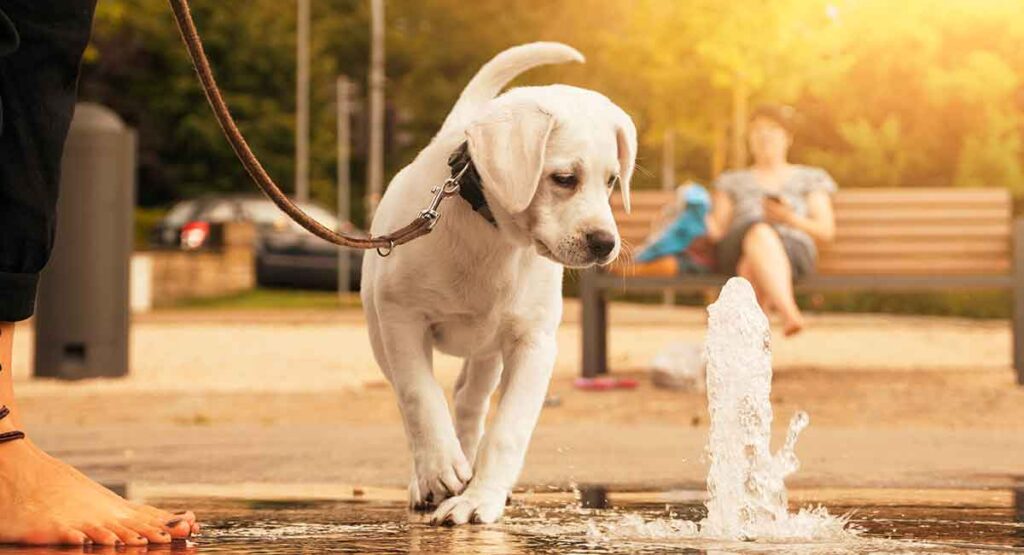
Charcoal Labrador
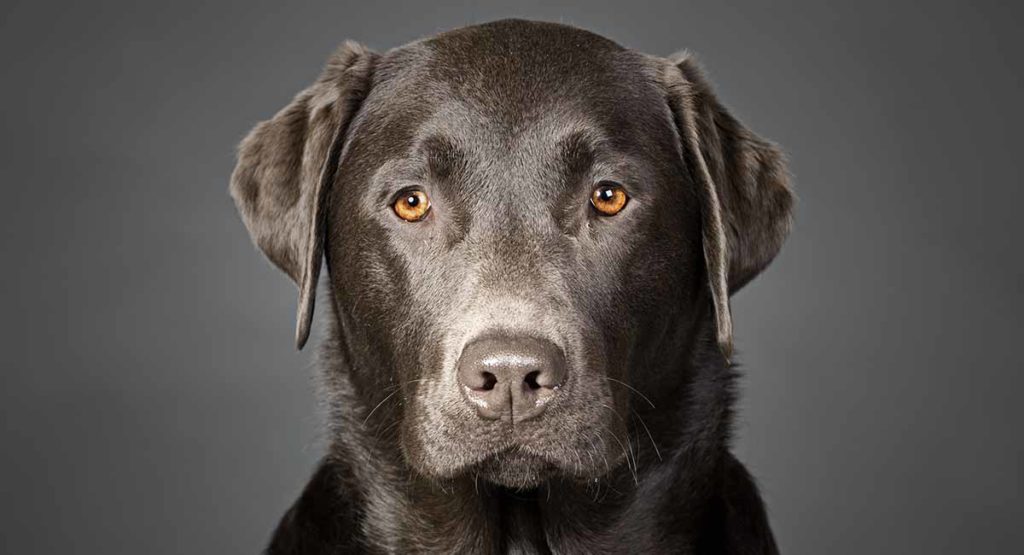
Know Your Lab Colors!
I’m going to explain the genetic code that controls Labrador color inheritance. And I’ll answer your questions about what puppy colors to expect when Labradors mate. I’ll try and keep it as simple as I can! Understanding how a Labrador’s coat color is inherited starts with understanding how the three basic colors are passed on from one generation to the next. So we’ll tackle that first.
Original Labrador Retriever Color
Black is the original, archetypal Labrador color, and genetically the most dominant. In fact, from the breed’s inception in the early 19th century until the turn of the 20th century, it was the only acceptable color. Chocolate and yellow puppies were frequently euthanized at birth. So how come they didn’t die out altogether? To understand that we have to look at the genetic difference between black and chocolate Labs.

Labrador Retriever Color Genetics
Both types get their color from a pigment called eumelanin. Labs with lots of eumelanin pigment in their coat are black. If they have a little less, they appear brown instead. The genetic instruction for being black or brown is held at the B locus in a dog’s DNA.
“Locus” is just a fancy term for a specific place in an animal’s genetic code. We use letters to tell each place apart – a bit like giving each locus its own zip code! The B locus is home to a pair of genes called B genes. One of the pair comes from your Lab’s mom, and the other from their dad. There are two types of B gene your Lab can get in their pair:
- One we call big B – it contains an instruction to make lots of eumelanin, and causes a black Labrador coat.
- And one we call little b – it contains an instruction for less eumelanin, and causes a brown or chocolate coat.
Big B is a dominant gene, and little b is a recessive gene. Which leads us to…
Why Black is a Dominant Lab Color
The three different combinations of B genes that a Labrador can inherit from his parents are:
- BB
- Bb
- and bb.
Dominant genes to switch off, or override, recessive genes. So dog with BB genes will be black, because he has two genes for a black coat. And a Bb dog will be black too, because the dominant B genethe recessive b gene. Only a dog with a matching pair of bb genes will express the instruction for less eumelanin in their coat, and be brown.
How Chocolate Labradors Are Made
Here’s a handy table to help you picture that relationship between B gene combinations, and Lab coat color. Remember that the black dominant gene always switches of the brown gene, so only the dog with two copies of the b gene will actually look brown.

How Labrador Colors Skip Generations
Chocolate Labradors have grown steadily in popularity in recent years. But the dominance of the black color enabled our chocolate friends to remain hidden and rare with the breed, for many decades. Generation after generation of black dogs can continue to have only black puppies if dogs with the Bb gene are only ever mated to dogs with BB genes. Let’s see how that looks:
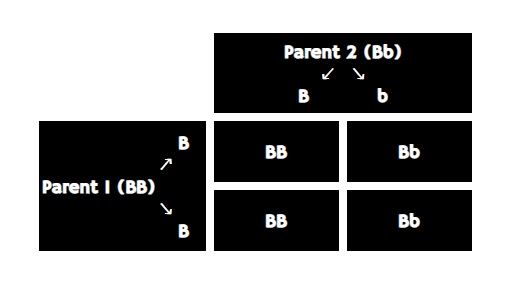
So you can see how the little b gene gets passed down through the generations without ever being expressed. In fact, it would take two black Labs both carrying the little b gene to produce chocolate puppies. Like this:
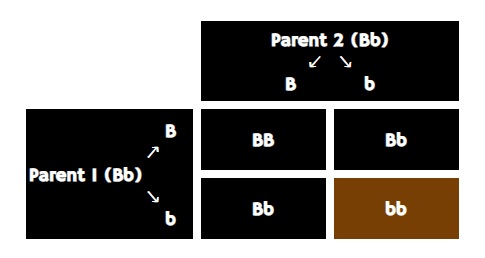
Statistically, one quarter of their litter would be chocolate colored. But like tossing a coin and getting heads several times in a row, it’s also possible for a Lab with Bb genes to pass the B version to every puppy in a litter, and only throw black puppies. And of course, some Labradors are neither black nor brown.
Where Do Yellow Labradors Come From?
Next, we’re going to look at the times when a BB or a Bb dog is not black at all. And when a bb dog isn’t brown!
The genetic information that creates a yellow coat comes from another pair of genes altogether. These genes are located at the E locus. And – you guessed it – we call them E genes. Just like B genes there are two versions of the E gene, big E and little e.
- Big E is the dominant gene. It does not interfere with the B genes.
- Little e is the recessive gene. It has the potential to mask the B genes that would otherwise give us black or brown coats. And the result is a yellow dog.
How Yellow Overrides Black and Chocolate
Only the little e gene can mask the instructions for black or chocolate fur. But little e is recessive, and if the dominant gene big E gene is present, the little e gene won’t work. There are three possible combinations of E gene that a dog can inherit. It could have
- two dominant genes (EE)
- two masking genes (ee)
- or one of each (Ee).
Only the middle of these three dogs will be yellow. In the first and third dog, the E gene will switch off the e gene, and the dog’s color will be determined by its B genes. Now let’s put all that information about B and E genes together!
Nine Different Possible Labrador Genotypes!
Every Labrador has a combination of B and E genes – called their genotype. There are nine different possible genotypes. Here they are in full:
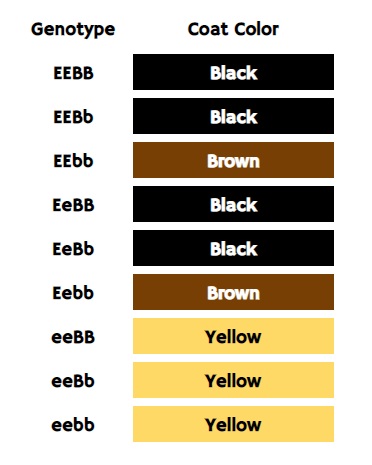
Can you see why each combination of genes turns out the way it does?
Predicting Labrador Retriever Colors in Puppies
Trying to work out what colors Labrador puppies will be is difficult without knowing the parents’ genotypes. Because as you can see, the second dog down the list may look black but he could throw brown puppies, and the fourth dog down the list may look black, but he could throw yellow puppies. The fifth dog down the list is also black but he could throw yellow and brown puppies. Puppy colors are easier to predict when both parents owe their appearance to the recessive genes b or e.
Mating Two Yellow Labradors
Two yellow Labradors mated together will never throw brown or black puppies. All their offspring will be yellow. This is because yellow dogs do not possess the big E gene which is needed to switch off the masking effect.
Mating Two Chocolate Labradors
Two brown Labs mated together will never throw black puppies because brown dogs do not have the big B gene. But two chocolate Labs can produce yellow puppies, if each of the parents carries the little e gene – like this:
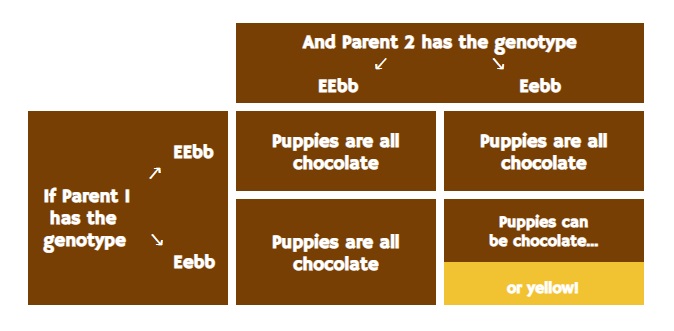
In the mixed litter, statistically one of half of the puppies will be chocolate and one half yellow. But just like tossing a coin, we know that the rules of probability aren’t the same as guarantees! That’s even more true when we start looking at other color combinations of parents. Let’s look at a few more examples
Can Two Black Labradors have Yellow or Chocolate Puppies?
Depending on their genotype, two black Labradors can indeed have yellow or chocolate puppies. Remember from our grid above that there are four different possible genotypes for a black Labrador. The genotype refers to the genetic code that the dog carries.
Four Ways to be Black
In the diagram below, I’ve put the four possible genotypes along the top to represent one parent – the mother for example. And the four different possible black genotypes down the side to represent the father. Inside the grid are the puppies that could be born from each combination.
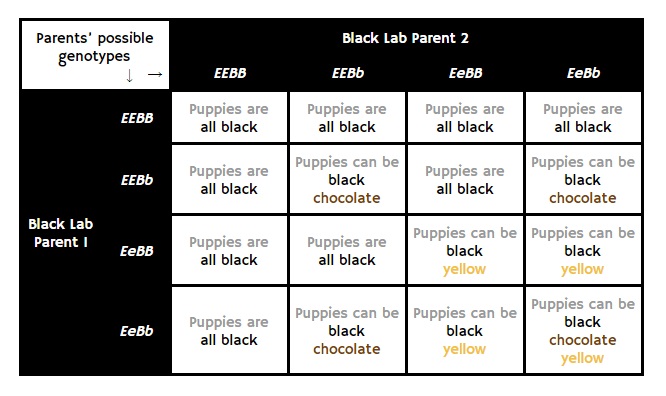
If and only if, both parents carry a little e gene, then some of the puppies may be yellow. Remember that your puppy needs two little e genes (one from each parent) in order to be yellow. If only one of two black dogs carries the little e gene, all their puppies will be black. But half will carry the yellow gene, and this is how the color can skip a generation
Is It Possible to Get All Three Colors from Two Black Dogs?
Yes it is, check out the bottom right hand square in the diagram above! Notice that it can only happen if both parents dogs have this genotype: EeBb. In other words, they both carry a little e and a little b.
Mating a Yellow Labrador with a Chocolate Labrador
Now let’s look at what color the pups will be if you mate a chocolate Lab with a yellow Lab. This is good example of how complicated, and unexpected, Labrador colors can be.
There are six different possibilities for litter color combinations depending on the genotype of the parents. You can even get a litter of all black puppies from a chocolate mother and a yellow father (or vice versa)! Here are the color possibilities:
- yellow, black, and chocolate puppies
- yellow and black puppies
- black and chocolate puppies
- yellow and chocolate puppies
- all puppies are chocolate
- all puppies are black
Let’s have a closer look and find out why. In this diagram I have put the yellow Labrador possible genotypes along the top, and the chocolate genotypes down the side.
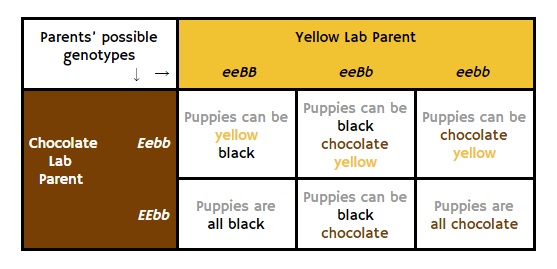
There are three ways to be yellow, and only two ways to be chocolate. A chocolate Labrador can be either Eebb or EEbb. That’s nice and simple. A yellow dog can be one of three different genotypes: eeBB, eebb, or eeBb – because every time two little e genes come together, they overwrite any combination of B genes. So, if a chocolate Lab with the genotype Eebb mates with a yellow Lab of the genotype eeBb, all the building blocks are there for puppies of every color. But if we mate EEbb with eeBB all the puppies will be black, because they will all have one big B and one big E.
Black Labradors Crossed with Chocolate Labradors
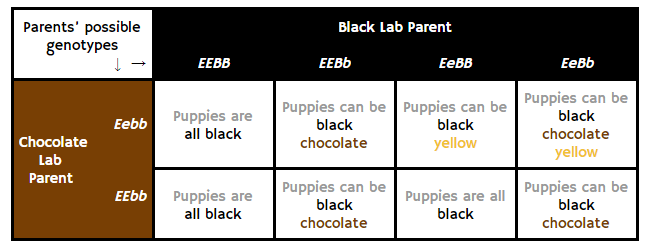
Let’s look now at what happens when we cross a black Labrador with a chocolate Labrador. We’ve seen that there are four different ways to be black, but that chocolate dogs only come in two different genotypes. That gives us 8 potential outcomes. The chart below has the different black Labrador genotypes along the top, and the chocolate genotypes down the side.
Finally, we’ll look at the last possible combination of standard Labrador colors. Black crossed with yellow.
Black Labs Crossed with Yellow Labradors
Because there are four ways to be black and three ways to be yellow, there are quite a variety of color pups for a mating between a black Labrador and a yellow Labrador.
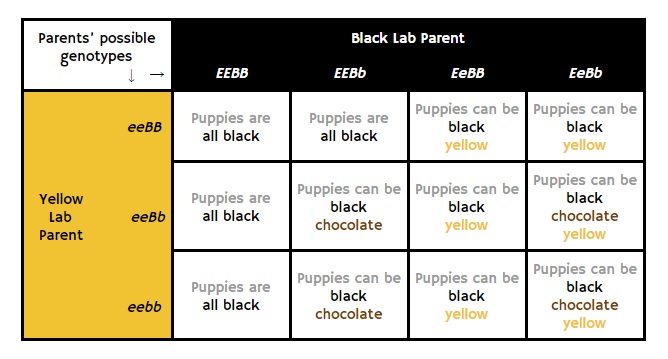
Of course, knowing what to expect depends upon knowing your sire and dams’ genotypes.
Some breeders might be able to hazard an educated guess based on observing several generations of litters.
But we’ve also seen how genes can remain concealed within a family tree for decades – so surprises are always possible!
And one of the biggest surprises of all for many breeders, is the silver Lab!
Silver Labradors
Last but not least, you may be wanting to know how silver Labradors get their coat color?
Silver is not among the traditionally recognised Labrador colors. Some of its detractors even believe it can only be possible if a Lab isn’t perfectly purebred at all.
But for lots of pet owners who don’t mind whether their Lab had a great, great, grandparent of a different breed, the possibility of an unusual and distinctive silver coat is rather special and appealing.
And that silver color comes from another pair of genes, which we haven’t looked at yet.
These are the Dilute genes.
Big D and little d.
The dilute genes have the potential to override all the other colors, albeit in a subtle way.
Labs have a pair of Dilute genes at the Dilute locus – DD, Dd or dd.
When two little d genes are paired together they dilute the coat color of the Labrador that carries them.
Silver Labs are chocolate labs with the dd genotype.
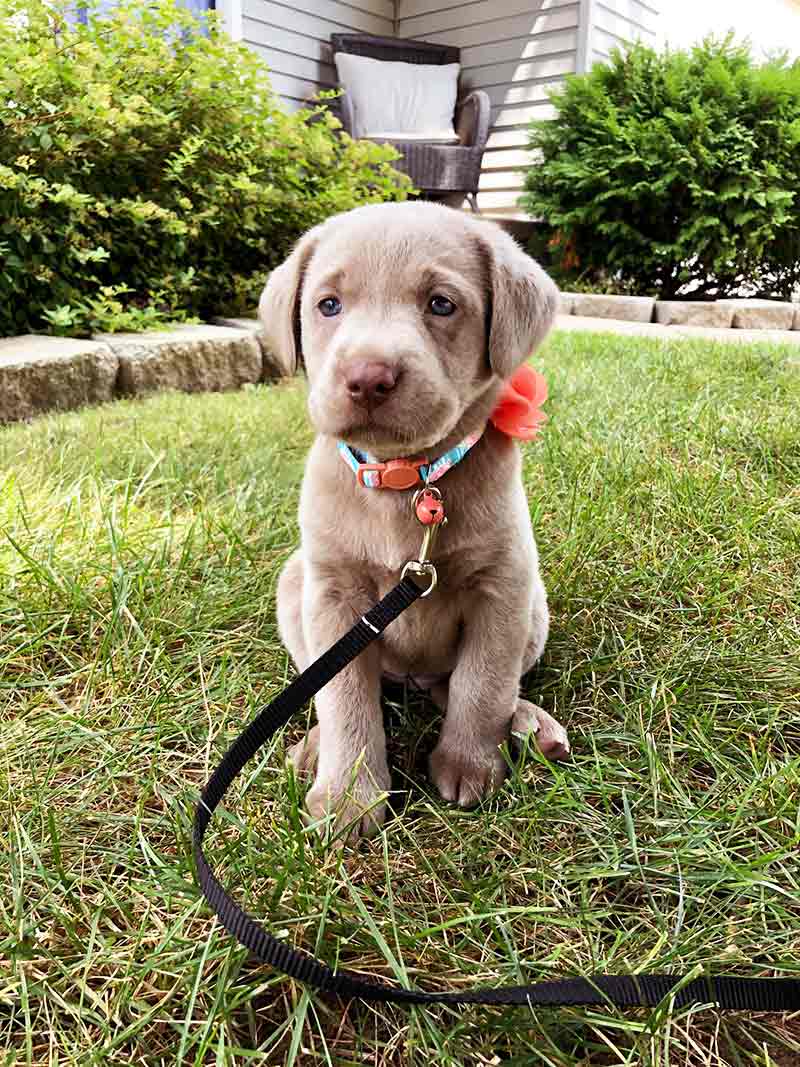
More Unusual Labrador Colors
The dd genotype dilutes the other Labrador colors as well.
In a black dog it gives a softer, charcoal coat color.
In a yellow dog a paler ‘champagne’ yellow.
Head over to our article on silver Labradors to find out more about why some Labs might carry the dilute gene, and what these unusual colors mean to Lab lovers.
Genetic Testing for Labrador Color Inheritance
For a lot of Labrador Retriever breeders, waiting to find out which Lab colors appear in their litter is part of the thrill.
But for breeders who prefer certainty over surprises, there are genetic tests to determine the genotypes of breeding dogs for the B, E and dilute genes.
Of course, knowing the genotype of your dogs doesn’t necessarily guarantee pups will be born in all the possible colors, or in statistically perfect proportions.
But they can give a valuable insight to, for example, a breeder specifically trying to avoid or achieve a silver Lab litter.
Rare Labrador Retriever Colors
If Labradors populations existed in the wild, we could expect chocolate to be the rarest Labrador color. That’s because of the nine possible E and B gene combinations, only two produce a chocolate coat.
But in the real world, Lab breeders have a degree of control over the color of puppies they produce, and they will be influenced by demand from dog owners.
Therefore, the frequency of each color in the Labrador population varies by region, and over time.
In the UK, black Labs are most closely associated with gundog work. But in the US, chocolate Labs have long been in demand as hunting dogs too.
And over time, more and more Labs have been reared purely for companionship. This means “novel” colors like silver and charcoal – previously considered unsuitable for working dogs – have gained their own fanbase.
So, the rarest Labrador color is subject to change over time, and difficult to keep track of.
Labrador Retriever Colors vs Intelligence
All Labs are intelligent and quick to learn new commands.
At the time of writing, we’re not aware of any research into the relative intelligence of Labrador colors.
In fact, it’s only in recent years that researchers have been satisfied that they can measure dogs’ intelligence in a reliable way.
This could be a valuable tool for assessing potential military working dogs and service dogs etc.
But it’s likely to be a while before we see it used to compared the intelligence of different color Labs.
In the meantime, you can find out why one Lab color has a reputation for being less smart than the rest over here.
Are Some Colors Better Than Others?
It isn’t unusual for people to be quite surprised by the color of the puppies in a litter that they have bred.
But as you can see, colors and indeed other inherited characteristics like certain diseases, can remain hidden from one generation to the next.
Potentially for many generations in a row if they are carried on a recessive gene.
It is enough to make your head spin!
But at the end of the day, beauty remains in the eye of the beholder, and your perfect Lab color won’t be the same as everyone else’s.
So which color do you like the most? And have you ever been surprised by an unexpected puppy color in a litter?
Tell us in the comments box!
If you want to refer back to any of the charts I have made for this article, you are welcome to do so providing you link to this website as the source.
References and Resources
- McGreevy et al, “Labrador retrievers under primary veterinary care in the UK: demography, mortality and disorders”, Canine Genetics and Epidemiology, 2018.
- University of California, Davis, “Genetic Diversity Testing for Labrador Retrievers”, 2018.
- Lofgren et al, “Management and personality in Labrador Retriever dogs”, Applied Animal Behavior Science, 2014.
- Everts et al, “Identification of a premature stop codon in the melanocyte‐stimulating hormone receptor gene (MC1R) in Labrador and Golden retrievers with yellow coat color”, Animal Genetics, 2002.
- Lazarowski et al, “Acquisition of a visual discrimination and reversal learning task by Labrador retrievers”, Animal Cognition, 2014.
The Labrador Site Founder
Pippa Mattinson is the best selling author of The Happy Puppy Handbook, the Labrador Handbook, Choosing The Perfect Puppy, and Total Recall.
She is also the founder of the Gundog Trust and the Dogsnet Online Training Program
Pippa's online training courses were launched in 2019 and you can find the latest course dates on the Dogsnet website

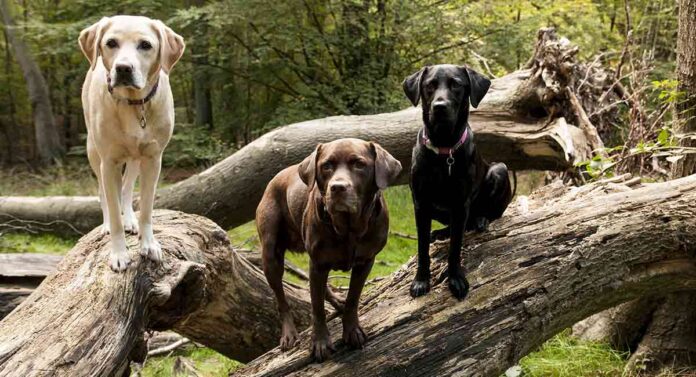
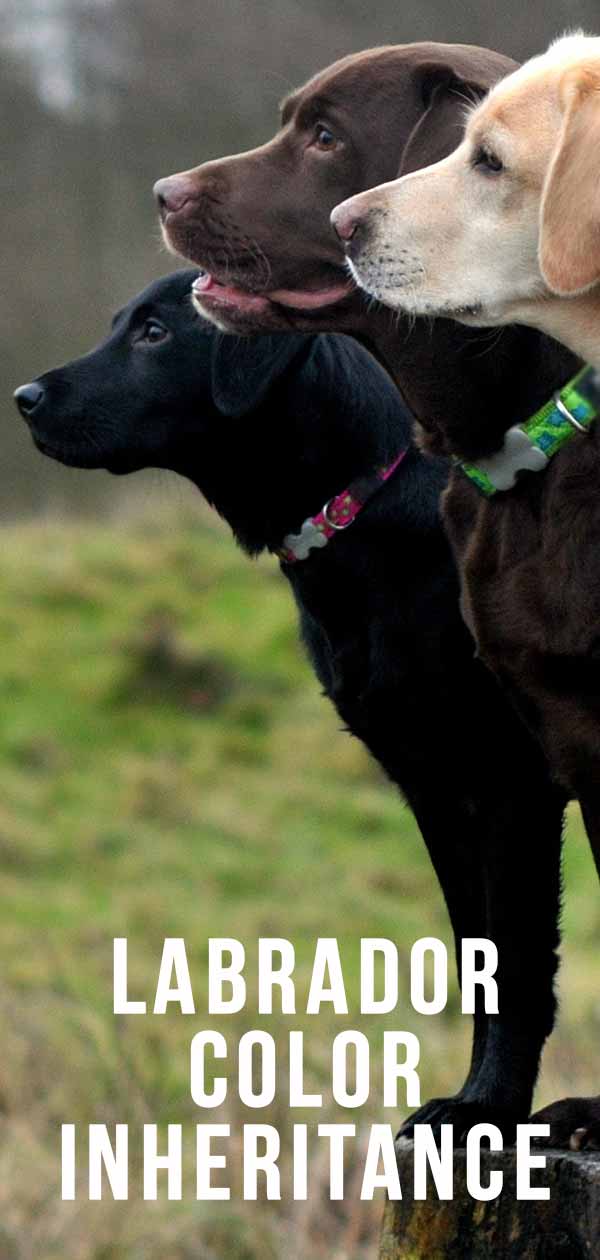




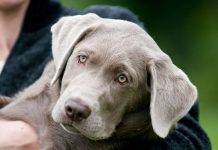


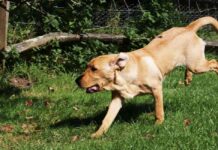
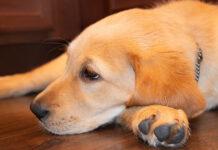








My 15 month old black male has tinges of chocolate. Is this rare? I can’t seem to find any information about it 🙁 It’s definitely chocolate and not a light grey undercoat which someone else suggested. Is it maybe because of seasonal changes? The father was black and the mother chocolate.
Can you give me any info on this?
Thanks, Frank.
Great article! We had a surprise when our two black labs produced a litter of 5 chocolates and 1 black! But now I know that both labs must have had Bb and we came up tales ten times in a row!
This is a great article.
My two labs have just had puppies. I was shocked that they had a all black litter.
Father is pure chocolate (his parents are pure chocolate) and mother is pure golden (her parents are pure golden).
Just wondering what their genotypes are then if she has thrown all nock puppies?
Brooks
Hello = Great article!
We have a goldador, Pepper, who is jet black with a flat coat, like his golden mother. He is from a black lab father x golden retriever mother. I presume this means he is (likely) EeBb. We would like to breed him to a golden retriever female. Will the coat color genes in the retriever be the same as you’ve described for the labs? In other words, would this cross result in EeBb x eebb if the golden retriever is pure bred?
Cheers,
David
Is it possible for a black lab and a brown lab to have a black puppy with golden legs and a white dot on the chest? We had 9 puppies: four black, four chocolate and the one described above. It is the second one I’ve seen (they are not related to each other- that we know off). She looks like a German sheprador puppy. Is there no doubt that the puppies are not “pure” Labrador?
I have a black Labrador with brown back paws, brown on his legs, brown behind, ans some brown on his chest. The brown is like the colors on a greater mountain dog. He is a rescue, My question is, can these colors come from both parents being Labradors or is he more likely a mix? Thanks
Hi. Not entirely a lab question but close and I am curious about dogs and their colours.
I’m in the UK and adopted a Goldador in January 2019. She was 15 months when she moved in with us. She will turn 4 next April 30th.
Goldadors are a mixed breed of Labrador Retriever/Golden Retriever and a charity here in the UK breed them to become Assistance Dogs. They also use full Labs and Goldenseal as well as Labradoodles. All have the ideal qualities to be Partnered with someone to assist them with their disabilities or mobility issues. I applied to adopt for any dog withdrawn from the training program. Amelia was due to distraction and recall issues. She was really in need of becoming a pet.
Anyway, we do not know about her parentage other than she was bred from a Labrador Retriever/Golden Retriever. The Charity are not obliged to provide this information.
Amelia is classed as ‘golden’ in colour. Her back/head and most of her legs are very gold in colour but in some lights appear almost red.
But her underside, belly, bottom and whiskers are almost white.
Finally, she has a jet black mark under her jaw about the size of an oval 10p piece.
I know we are drifting away from Labs as such, but this article really got me wondering what her parents were; both in breed, full or mixed; and what colour.
Fascinating.
We are planning on breeding two black labs. Both of their parents were yellow moms with brown dads. Am I correct in assuming they would each carry the recessive b and recessive e genes, then? Thanks in advance for your input.
Good article! I never knew about fox red labs before I read it. Is this color really rare?
I have a question. I understand the genetics of modern labs as presented. However, it is my understanding that labs came from St. John’s Water Dogs who were also the progenitor of Newfoundland Dogs. If Saint John’s dogs and Newfoundlands are all black how did the first yellow dog appear? I understand the modern yellow color, but was there some other dog introduced to the mix if it’s ancestors were mainly black?
I have just got a chocolate puppy and his breeder told us his mum and dad are yellow!
I have dads papers and saw mum but I feel I have been lied to!
My puppy is going well and his gorgeous but I am worried!
Do not worry I owned the most beautiful chocolate lab for almost 15years she was from a yellow mum and yellow dad I was there at her birth her mum only had black and chocolate pups I knew both my dogs parents and they were pure breed so I think it’s rubbish what’s out in this article! My dog was one of the best dogs you would ever know so enjoy your Labrador xxxxxx
In both these cases the breeder either knowingly lied about the sire, or somehow – without the breeder’s knowledge – the dam also managed to mate with A.N. Other non-Yellow dog whose sperm was able to fertilise some or all of her available eggs (a dam can carry puppies from multiple sires if the opportunity arises). In the 2nd instance the breeder would have been pretty clueless in order to have confidently claimed the sire to be a Yellow Lab. Sorry – but there it is. Genetics doesn’t lie: 2 Yellows can only produce Yellows pup. Same as two blue-eyed humans can only produce blue-eyed children.
Sorry I miscalculated before EEBB Eebb produces EEBB EEBB EeBb EeBb means all black thank you
EEBB Black mating with Eebb may produce EEBB BLACK EEbb BROWN EeBB BLACK Eebb BROWN means 50% chances for both
We have Fox red labs and they are wonderful. According to AKC standards I gather they fall under yellow labs. Do the fox red labs have the exact same traits and characteristics as their yellow brethren?
Yes. Yellow labs shading goes from almost a white to the darker red color referred to as fox red. But they are all officially yellow labs.
Is it possible though for that shade of yellow lab to be made from chocolate lab color genes? The presence of red (which often makes brown colors) in a yellow lab makes me think that there must be recessive brown genes in the mix somewhere
I had 2 litters of AKC Labs around 20 + yrs ago both litters from same black Female from Mayo Kellogg’s Labs in SD & she was bred to another black & produced 6 yellow 5 black puppies – I kept one Black pup & As I have always praised the moms drive & could go thru any cover & was super smart & easy to train her pup turned out even better mostly because her mom taught her everything in the field & water All I had to really do was basic obedience & later hand signals – they were both obsessed with hunting & competitive- it truely was a blessing living & hunting all of North Dakota
Her second litter was again a mix of Yellow & Black as she was bred to a excellent yellow – There was one pup in that litter I wish I had kept a Pure White Male that was twice as big as the others the whole time I had them – I would have loved to seen her full grown & maybe have seen her hunt once, but if I recall right the Folks who got her were not hunters but what a Big Beautiful Lab
This was so helpful. Reading other articles on coat color genetics made my eyes cross and glaze over. I was trying to figure out how a yellow Labrador retriever and a Parti standard poodle (beige & white) produced black labradoodle offspring. Although you didn’t delve into poodles, I think I can surmise from this article that it is possible, yes?
You didn’t even mention a tanpoint.
Great article!
I think there is a cell mixup in the “ Black Labradors Crossed with Chocolate Labradors” chart. The Black – EeBB and EeBb Columns have the possible results reversed. For example, the EeBB black intersection with chocolate EeBB says that all the puppies will be black. I think it should have the text from the cell below, yellow or black since you could have two ee’s. Same with the EeBb and Eebb intersection.
Hi John, You are absolutely correct! Well spotted, and thanks for pointing it out. We’ve corrected that table now. Best wishes, Sarah, Labrador Site HQ
I have a Lab and she is black with brown bridle stripes on her butt , when I got her she was all black but as she got older the brown stripes started showing up. She is now 14 years old
We have a 7.5 month old black lab. AKC,with dna back ground.His mom was yellow dad was black.
We are getting a black female but don’t know her background.shes also AKC registered.
Since mom was yellow is there a bigger chance of them having yellows if we breed?
what about the brindle and tan pattern in labs. it does exist, even in pure labs
SO what happens if you bred a Silver with a black or a red with a black????
So we have a charcoal female and a a red fox male and looking to breed in the near future. According to your info we could have everything but charcoal. Am I reading it right?
I bred a Male Black Lab with a female Chocolate lab. Out of 10 puppies, 5 are black and 4 are chocolate and 1 is mainly chocolate with black streaks… Beautiful puppies!!!
Whoa! Cool! Is it possible to post a pic? Also, I believe this is a bizarre case of brindle, which I think does not occur with labs very often. Still, that is amazing!
Have you ever heard of a pure black lab turning part brown around 1 1/2 yrs of age?
I have a beautiful Silver Lab (Chocolate) and am considering breeding her with a Charcoal Lab. Are both dd genes?
Thanks for this article, as it helped me understand what color pups I can expect from my yellow if I breed her. I do have a question, though: How does the ‘dudley’ lab trait play into the possible color traits of offspring, if at all?
Hi
I have a chocolate lab and he is 1/4 German short haired pointer. I am going to get a female and bred them and was wondering if you can do DNA testing or something to see the genotype before you bred them to determine what color of pups you will have.
Is this a typo below by chance?
The Chart appears to be correct but you have 2 (eebb) in the description.
Shouldn’t the 2nd eebb below be eeBb which would match the Chart.
“A yellow dog can be one of three different genotypes: eeBB, eebb, eebb – because anytime two little ee s come together they switch off the three different possible combinations of bee genes.”
Well spotted, Jamie! It’s now been fixed 🙂
Thank You.Great article btw.I have a Black Lab & I enjoyed reading this & I have a much better understanding now of Coat Colour.I’ve been looking back through her Family Tree since reading it.
Really interesting article which, albeit retrospectively, has helped me understand more about my own chocolate lab. I think that these genetic combinations ought to be used on next year’s maths examinations too….
Is it safe to buy a chocolate lab with the puppies mother being chocolate and father is silver. And breeding it with a dominant yellow lab? ALso would it have skin issues with having a silver trait?
If you look real close I can see black, yellow, and of course chocolate which she is. Is this normal and will she grow out of it. She is 6 months old. Thanks
I just had puppies and we are unsure what we got here.
My male is a chocolate lab and the female is a charcoal lab.
I have 4 chocolate puppies but 4 that look like their mom. Would they be charcoal or would they be black?
Thanks
hi I’m new to labs and there babies.I have a cream female and a black male what colour babies might I get??
You could always read the article
I have a purebred 4 year old female choc lab I recently adopted from a breeding kennel. When I brush her, the hair in the brush looks white. Yes, she does have a few stray white hairs but not enough to turn what is in the brush white and then I noticed that each hair shaft is banded (agouti ) with the lower half of the hair shaft pure white and the top half brown. All the material I could find on the topic states ” the recessive Agouti alleles will have no effect on the black/chocolate coloration. It is for this reason that one only observes the effects of the Agouti alleles in the yellow Labrador.” Her father was a (Cy) and his father was a (Byc) and his father was a (Yc). So I am wondering is this a fluke of nature or is she really a brunette yellow lab.
I have a black lab and he has a little streek of white or silver down his chest and a little tuft on his chin is this normal. He came from 2 black parents
Hi Jacinta, it is not unusual for a purebred Lab to have a little spot or streak of white on his chest. White on the face is less common but it does occur
I have a 7 year old black lab (akc registered). Aside from a little age related white on her face now, she’s always been pure black from nose to tail. However, recently, I’ve noticed her coat on her sides looks like it’s turning brown. Could this be happening because she has a recessive brown gene? Is it possible that she could turn completely brown?
This is not how a “recessive” gene works. I’d suggest, like the fur around the jaw etc that goes white/grey with age, the fur changing to a lighter colour on the sides is also age related.
I have a five month old black lab. The mother was yellow and the father silver. My pup is brindled. Is the rare? I not finding a lot of information on her color.
We bred a black female and our yellow. I’m a little confused. She threw black, chocolate, yellow, and 3 Brinel puppies. 12 total. The Brinel are 3 different shades. From light yellow, to brown to black.
Can someone help me understand what genes my female lab and the stud carry? Both are black labs that carry the silver gene. Summer of 2016 she had her first litter. She had 3 blacks, 3 chocolates, 2 yellow(champagne Coler) and 1 silver.
I love dogs and they are so hard to control but they are so adorable i love little dogs exspecialy labs and danes and dalmations but the most of all i love all the labs
I have 2 black brothers from the same litter. One has a white patch in his chest even though the mother was a pure-bred and the father one generation removed.
Am I neive in thinking they are not lab mixes?
Hi Caroline, You might find this article of interest: https://www.thelabradorsite.com/is-my-dog-purebred/
I love this article! Makes it so simple and fun to understand.